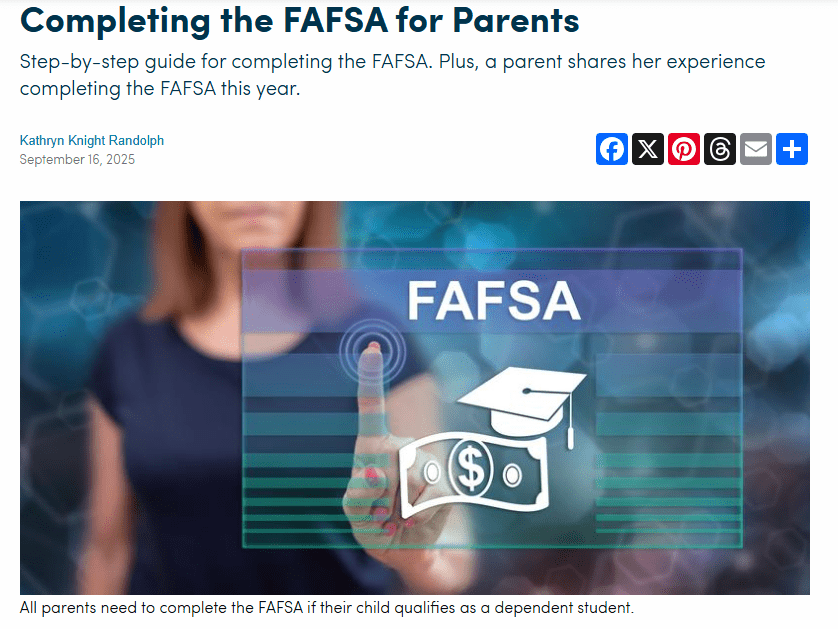Seniors! Financial Aid Applications Will Open Soon!
FAFSA Changes Are Coming: What You Need To Know
Each year, millions of students fill out the Free Application for Student Aid (FAFSA) to get help to pay for college. This help comes from federal and institutional aid, such as grants, scholarships and loans.
For the 2024-25 award year, the FAFSA is getting a facelift that includes a redesign and fewer questions. Plus, formulas determining aid eligibility have been modified with the goal of expanding financial assistance for low-income families.
This recent FAFSA overhaul puts into practice laws enacted in the FAFSA Simplification Act, part of the Consolidated Appropriations Act of 2021 and amended by the Consolidated Appropriations Act of 2022. When preparing to submit the FAFSA for next school year, these are six changes to be aware of:
1. The FAFSA Application Opens Later
The FAFSA for the 2024-25 school year is projected to be available in December 2023, a few months later than usual. In years past, FAFSA applications opened up each October before the start of the next academic year.
A December opening date means the FAFSA launch could coincide with school breaks and holidays, but don’t put off completing it until the new year. Some needs-based aid may be offered on a first-come, first-served basis, and submitting your FAFSA sooner than later could increase your chances of qualifying for funding while it’s available.
This date change is temporary as the Department of Education intends to move the FAFSA opening date back to Oct. 1, 2024 for the 2025-26 academic year.
2. New Methodology Calculates Aid
A major change is that FAFSA’s new Student Aid Index (SAI) replaces the expected family contribution (EFC) metric to calculate aid eligibility.
In general, the SAI and EFC work similarly. Each number represents an amount that estimates what families can pay for a student’s education costs, and it considers factors like household income and assets.
Your eligibility for need-based financial aid is determined by subtracting your SAI (previously EFC) and other financial assistance from the cost of attending school. Here’s the equation:
Cost of Attendance (COA) – Student Aid Index (SAI) – Other Financial Assistance (OFA) = Financial need
The calculation for the SAI considers the income and assets of the student and others financially contributing to their household, like parents and spouses. Below are some key ways the SAI differs from the EFC:
- Fewer questions asked to determine financial standing. The new FAFSA application requires that financial information be pulled directly from IRS data when possible, so there’s less information to enter manually. The old FAFSA had over 100 questions, while the new one has less than 50.
- You can have a minimum SAI of -$1,500. The old EFC metric allowed a minimum estimated family contribution of zero after considering income, assets and other factors. With the SAI, you can have a contribution below zero.
- Families don’t get a break for having multiple students in college. The new methodology no longer considers the number of family members attending college to determine aid. This means families with multiple college students could receive less aid for the 2024-25 school year. However, schools can adjust offers at their discretion, considering the financial burden of having many students in school.
- Students must report the income of the parent who provides the most support. Instead of reporting the income of the parent they live with for most of the year, dependent students of divorced or separated parents now need to report the income of the parent who provides the most financial support.
- Some income isn’t considered in aid calculation. You may no longer have to include some untaxed income to your FAFSA application, such as money received from extended family members, like grandparents. Other untaxed income—such as housing and living allowances paid to service members—may also be excluded from the aid analysis.
If you’d like to look further into the new SAI methodology for calculating financial aid, the Department of Education has a preliminary eligibility guide for review.
3. Students May Automatically Qualify for the Maximum Pell Grant
Pell Grant eligibility is tied to how household income and family size compares to poverty guidelines. Pell Grants are a type of aid that doesn’t have to be repaid; grants are awarded to students with an “exceptional” financial need.
Independent and dependent students below the poverty threshold may automatically qualify for the maximum Pell Grant. For example, students in single-parent households may be eligible for the maximum Pell Grant if their adjusted gross income (AGI) is less than or equal to 225% of the poverty guideline for their family size.
Students from a two-parent home (and independent students without dependents) may qualify for the maximum grant amount if their AGI is less than 175% of the poverty line.
In addition, access to Pell Grants is now open to confined or incarcerated students and students who were defrauded by a school or who attended a now-closed school.
4. Everyone Needs an FSA ID To Complete the FAFSA Application
For the 2024-25 school year, anyone required to fill out part of a student’s FAFSA—including a spouse, parent or step-parent—must create their own FSA ID and password.
The FSA ID provides a digital signature on your application for security reasons. Application contributors can set up an FSA ID on the StudentAid.gov website by providing their birth date, Social Security number and full name.
5. Consent Is Required for Tax Data Transfers
You can digitally transfer much of the information required for the FAFSA from the IRS, but the transfer requires consent from each application contributor. So, if a spouse or parent needs to fill out part of your FAFSA, they must agree to provide their tax details.
Application contributors should get a FAFSA notification requesting their consent. If they don’t agree to have the IRS information transferred, students can still apply for aid, but may not qualify without consent.
6. Students Can List Up to 20 Schools on the Digital Application
Students can now list up to 20 schools on the online FAFSA application. This allows you to put many different school options on your list. However, if you fill out the PDF version of the FAFSA, you’re limited to 10 schools.
How To Prepare for Your FAFSA Application
The launch date of the new FAFSA for the 2024-25 school year is still several months away, but taking the steps below could help students and parents prepare before it opens.
- Locate your Social Security card. If you’re a high school student, you may not have your Social Security number committed to memory yet. Consider tracking down your Social Security card so you have it ready for the application. If it’s misplaced, you have time to request a copy from the Social Security Administration.
- Set up an FSA ID. Students and application contributors can set up FSA IDs before the FAFSA opens, so that’s one less task to worry about when it’s time to apply.
- Figure out your dependency status. Students answer questions during the FAFSA application to determine if they’re an independent or dependent student, but you can answer preliminary questions on the StudentAid.gov website to anticipate what the dependency status might be. This way, students can give parents and other application contributors a heads-up if they’ll need to fill out parts of the FAFSA.
- Mark your calendar for a December launch date. Make a note to yourself to start looking for FAFSA launch updates in the fall so you can start the application as soon as it opens.
Remember that the changes referenced above are for the 2024-25 award year, which is the next academic school year. If you need financial aid for the current school year (award year 2023-24), the FAFSA application is open, and the deadline is June 24, 2024.
The Bottom Line
The exact launch date of the new FAFSA for the 2024-25 school year has yet to be announced. When it goes live, the application is designed to take you less time to complete than past versions. If you have questions about financial aid applications, please contact your Career Guidance Counselor or School Counselor.


